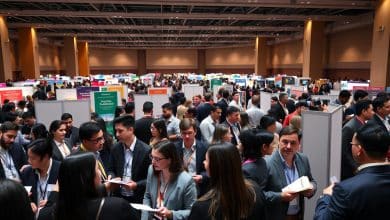What Internships Lead to Sponsored Roles in the US, Canada, and Europe?
Many international students dream of launching their professional journey abroad. They seek practical experience in competitive global markets. A sponsored training program offers this chance while providing legal work authorization.
Companies across North America and Europe increasingly recognize the value of international talent. They actively seek skilled individuals from around the world. These organizations now offer visa support to attract promising candidates.
Different countries have specific visa pathways for these opportunities. The United States uses the J-1 visa for cultural exchange programs. Canada provides various work permits for temporary employment. European nations each have their own visa categories for professional training.
This guide helps readers identify industries that offer these valuable positions. It explains eligibility requirements and application processes. Understanding these pathways can transform long-term career prospects.
Securing such a position builds professional networks across borders. It develops cross-cultural competencies that employers highly value. Key organizations facilitate these international experiences while ensuring legal compliance.
Overview of Internships and Sponsored Roles
Many aspiring professionals seek structured international training programs that come with legal employment rights. These arrangements provide valuable work experience while ensuring compliance with immigration laws.
Defining Sponsored Roles in International Development
Sponsored positions involve employers or designated organizations providing legal work authorization through visa sponsorship. In the United States, these opportunities primarily operate through the J-1 Exchange Visitor Program.
Designated sponsor organizations like CIEE serve as intermediaries between candidates and host companies. They ensure regulatory compliance and handle visa documentation throughout the program duration.
How Sponsorship Enhances Career Opportunities
These programs create legal pathways for gaining hands-on experience with prestigious companies. Participants access professional networks that span international borders.
Unlike tourist or student visas, these training programs focus specifically on professional skill development. The structured training plans align with participants’ field of study or career objectives.
CIEE has facilitated cultural exchange for over 1.1 million participants since 1947. The organization currently sponsors more than 35,000 international students and professionals annually.
These programs create a framework where participants receive mentorship and skill development while host companies benefit from diverse talent.
Internships Leading to Sponsorship
Professional development pathways exist across multiple industries for those seeking international work experience. These structured programs combine practical skill development with legal work authorization.
Key Industries Offering Sponsored Internships
Technology and STEM fields consistently rank among the top sectors for international training programs. Companies in software development, engineering, and biotechnology actively seek global talent. These positions often involve cutting-edge research and innovation.
Business, management, and finance represent another major category for professional development. Multinational corporations use these programs to cultivate future leaders. The experience includes exposure to global commerce practices.
Healthcare and medical fields provide valuable training opportunities. Participants gain experience in hospitals, research facilities, and public health organizations. These programs help develop clinical skills and international medical knowledge.
Hospitality and tourism industries offer positions in hotel management and culinary arts. Interns learn customer service excellence in international settings. The training focuses on global hospitality standards.
Cultural Vistas authorizes J-1 visa sponsorship across eight field categories. These include arts, education, media, and public administration. Each program follows specific training guidelines and duration requirements.
Eligibility Criteria and Program Requirements
Clear eligibility guidelines determine who can participate in cross-cultural professional exchange initiatives. These standards ensure candidates possess the necessary background for successful training experiences. Organizations like Cultural Vistas establish criteria that applicants must meet.
Academic and Professional Qualifications
Educational background forms the foundation of eligibility requirements. Current enrollment in a post-secondary program or recent graduation typically qualifies candidates for intern positions. More experienced professionals need relevant degrees plus work experience.
Language proficiency represents another critical qualification. Applicants must demonstrate sufficient English skills through standardized tests or interviews. This ensures effective workplace communication and integration.
Documentation and Application Necessities
Proper documentation validates candidate qualifications during the application process. Official transcripts, valid passports, and proof of financial support are essential. Health insurance meeting specific standards is also required.
Candidates must make sure their proposed training aligns with their academic or professional background. The application materials should clearly demonstrate this connection. Complete and accurate documentation prevents processing delays.
The intent to return home after program completion is a fundamental requirement. This is often shown through employment offers or family connections. Each element contributes to a successful application.
Navigating the J-1 Visa Application Process
The journey to obtaining a J-1 visa involves a clear, multi-stage process managed by designated sponsor organizations. These entities guide both candidates and host companies through each requirement. Understanding this timeline is crucial for a smooth experience.
Step-by-Step Guide to the DS-7002 and DS-2019 Forms
The process starts when the candidate and host company submit separate applications. Official documents prove education and employment qualifications. Sponsor organizations like Cultural Vistas then evaluate the submissions.
Standard evaluation takes approximately four weeks. If approved, the sponsor provides the DS-7002 Training/Internship Placement Plan. This key document outlines learning objectives and job duties.
Both the applicant and supervisor must review and sign the DS-7002. This confirms the training plan’s alignment with career goals. After receiving the signed plan, the sponsor issues the DS-2019 form.
The DS-2019, or Certificate of Eligibility, is typically issued within two business days. It is sent via encrypted email with arrival instructions. This form is essential for the next step: the visa interview.
Understanding Visa Interview and Processing Times
Applicants must complete the DS-160 online form and schedule an interview. They must bring the original DS-2019 to their appointment at a U.S. Embassy or Consulate. The final visa approval decision rests with the consular official.
Interview wait times and processing can vary significantly. They often average between two to four weeks. Applicants should check current wait times for their specific location.
Experts recommend starting the entire application process two to three months before the desired start date. This allows ample time for each stage. Sponsor organizations provide valuable support throughout this period.
Global Sponsorship Programs Across the US, Canada, and Europe
A comparative look at sponsorship frameworks highlights the unique approaches of the US, Canada, and European nations. Each region has developed specific systems to facilitate international professional exchange.
Organizations like Cultural Vistas play a key role. They provide access to these programs from most countries and in many fields throughout the year.
Comparative Analysis of Sponsorship Opportunities
The United States relies on the J-1 Exchange Visitor Program. Designated sponsor organizations manage placements across all states. This program allows for training periods up to 18 months.
Canada’s system, International Experience Canada (IEC), includes an Internship category. It requires an offer letter from a Canadian employer. Work permits under this program typically last up to 12 months.
European frameworks are more diverse. Germany and France, for example, offer specific internship visas for non-EU citizens. These also generally permit stays of around 12 months.
Key differences between regions include:
- Costs: U.S. programs often have sponsor fees and insurance requirements. Canadian options may involve lower overall costs.
- Company Vetting: U.S. host companies face more stringent approval processes compared to some Canadian and European employers.
- Specialized Pathways: Programs like IAESTE focus on STEM exchanges, while Korea WEST combines work and study.
Despite different rules, all programs share common goals. They promote cultural exchange and professional development for global talent.
Benefits of Securing a Sponsored Internship Role
Engaging in sponsored professional development abroad delivers transformative outcomes across multiple career dimensions. Participants gain legal work authorization that eliminates visa concerns, allowing complete focus on growth objectives.
Technical skill development represents a core advantage. Interns work with industry-standard tools and methodologies used by professionals daily. This hands-on experience builds practical competencies that classroom learning cannot replicate.
Soft skills naturally improve through workplace interactions. Communication abilities, problem-solving approaches, and teamwork collaboration all strengthen. Cross-cultural competencies develop as participants adapt to different work environments.
Networking opportunities create lasting professional relationships. Interns connect with colleagues, supervisors, and industry leaders worldwide. These connections often lead to job referrals and collaborative opportunities throughout one’s career.
Research shows participants with this experience are twice as likely to secure employment after graduation. The combination of technical skills, cultural awareness, and professional networks creates a comprehensive foundation for success.
How to Find and Apply for the Right Internship Opportunity
Effective internship hunting combines digital tools with established organizational partnerships. Candidates should first determine if they need placement assistance or already have a pre-arranged position.
Utilizing Online Job Boards and Networks
Specialized platforms like Intrax Global Internships offer curated listings from vetted companies. These resources provide filtering by location, industry, and compensation level.
Traditional job search sites can also yield results when using specific terms. Networking through university centers and professional groups often uncovers unadvertised positions.
Partnering with Trusted Visa Sponsors
Organizations like Cultural Vistas and CIEE maintain relationships with host companies. They offer matching services or documentation support for pre-arranged placements.
Candidates should make sure their application clearly communicates qualifications and alignment with career goals. The process typically requires separate submissions from both intern and host company.
Requesting information from multiple sponsors allows comparison of services and processing times. This helps identify the best partnership for individual needs.
Application Process and Expected Timelines
Understanding processing timelines is essential for successful international program participation. Candidates should plan their submission strategy well in advance of their desired start date.
The standard review period typically spans four to six weeks. This timeframe begins when both the candidate and host company submit complete documentation.
Standard vs. Expedited Processing Options
Sponsor organizations offer different processing speeds to accommodate various needs. The regular service includes thorough evaluation of all materials.
Expedited options provide faster review for urgent situations. Five-business-day processing carries an additional $1,500 fee. Ten-business-day service costs $1,350 extra.
These accelerated services only affect the sponsor’s internal review timeline. They do not shorten subsequent steps like embassy appointments.
After approval, the DS-7002 training plan requires signatures from both parties. This step usually takes a few days depending on response times.
The DS-2019 form then issues within approximately two business days. Embassy processing adds another two to four weeks to the overall timeline.
Starting the entire process two to three months before the intended start date ensures smooth progression. This allows adequate time for each stage without unnecessary pressure.
Accessing Resources and Expert Guidance
Sponsor organizations provide comprehensive assistance that extends well beyond visa processing. They offer continuous support throughout the entire program duration. This multi-layered approach ensures participants have access to necessary resources.
Support from J-1 Visa Sponsors and Cultural Exchange Experts
Designated organizations maintain 24-hour emergency support hotlines. Experienced professionals staff these services to address urgent questions. They assist both exchange visitors and host organizations across different time zones.
CIEE offers multilingual support for participants needing assistance in their native language. This proves valuable during complex compliance situations. The dedicated client relations team conducts regular program evaluations.
Additional Tools: Insurance, Orientation, and Networking Events
Pre-arrival orientation materials cover practical living and working topics. These resources help participants adjust to American culture. They include guidance on banking, housing, and transportation systems.
Health insurance represents a mandatory program component. Cultural Vistas offers three coverage tiers:
- Standard Lite at $60 monthly
- Enhanced coverage at $100 monthly
- Family Lite option at $120 monthly
Networking events in major cities connect participants with other professionals. These cultural activities build friendships beyond workplace relationships. They form an important part of the exchange experience.
Tax preparation software helps interns navigate filing requirements. Alumni networks provide long-term career resources. This comprehensive support system addresses diverse participant needs.
Success Stories and Real-World Case Studies
Success metrics from actual participants reveal how structured work experiences abroad transform career paths. These documented journeys provide compelling evidence of program effectiveness.
Profiles of Interns Who Achieved Sponsorship
A hospitality management student gained valuable experience with a Bay Area hotel chain. By day, they learned hotel operations. Evenings involved hiking with fellow participants.
A finance professional from Europe completed a year-long training program. They tackled challenging projects at a global technology company. Weekend road trips provided cultural immersion.
A biomedical science graduate conducted cancer research for a full year in Boston. This opportunity involved working alongside leading scientists. Lasting friendships developed with American colleagues.
Research shows paid participants are approximately twice as likely to receive job offers after graduation. Many secure positions with global companies upon returning home.
These experiences demonstrate how international programs provide professional development and cultural learning. Participants build networks that open doors to future opportunities.
Conclusion
Global professional training programs open doors to international careers for qualified candidates. These structured pathways offer valuable work experience across multiple countries and industries.
Success requires careful preparation and understanding of eligibility requirements. Applicants should partner with established sponsor organizations for guidance.
The investment yields substantial returns through skill development and professional networking. Research shows participants nearly double their job placement rates after graduation.
Students and recent graduates can begin by researching available opportunities. Requesting information from trusted organizations represents the first step toward this transformative career experience.
FAQ
What is a sponsored role?
Which industries commonly offer internships that lead to sponsorship?
What are the typical eligibility requirements for these programs?
How does the J-1 visa application process work for an intern?
What are the main benefits of securing a sponsored training position?
Where can I find legitimate opportunities?
What support can I expect from a J-1 visa sponsor?
Published on: 15 de October de 2025

Galena Garcia
Galena Garcia is the visionary behind Portal Santista. With a degree in Business Administration and a specialization in Marketing for the financial sector, Galena brings years of experience from the corporate world, where she developed a deep passion for helping both businesses and individuals thrive financially.
Driven by a desire to share her knowledge with a broader audience, she founded Portal Santista—an online space dedicated to providing useful, practical, and reliable information on finance, marketing, and business management.
Outside of her professional life, Galena is an animal lover, a devoted reader of romantic novels, and loves spending fun moments with her nieces and nephews. Her unique blend of technical expertise and genuine care for people is what makes Portal Santista such a special place.






